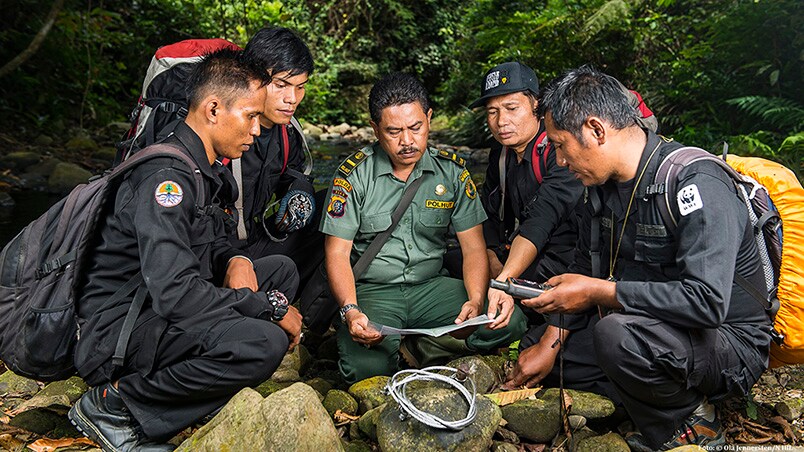This week Richmond players Nick Vlastuin and Jack Graham will visit Sumatra as part of the Club’s conservation partnership with WWF-Australia. In the lead up to the trip, Dr Ashley Brooks provides an insight into the plight of the Sumatran tiger and what is being done to protect and grow the population.
There are as few as 400 Sumatran tigers remaining in the wild. It is significant, but why? And why should we care? Let’s go back a step…
A hundred years ago there were an estimated 100,000 tigers roaming almost the entire Asian continent. Imagine this massive cat drinking from fresh waters of the northern Caspian Sea, to trudging through mangroves in eastern India, to trying to keep warm at 5,000 m altitude in the Bhutan Himalayas, or roaming the vast pine forests of the Russian Far East, and all the woodlands and forests in between. At some point in time, tigers would have even walked along Kuta Beach in Bali. Yes, tigers were everywhere. But over time they were hunted for sport, for their skins, and for their body parts. And as our needs for timber, food and space increased, we gradually cleared tiger habitats to sustain our lives and the needs of cities and markets globally. Poaching, hunting, and habitat clearing alone resulted in the decimation of wild tigers, with numbers dropped by 97% within the last 100 years, and only as few as 3,900 tigers in the wild today. From occupying 29 countries, tigers now only exist in eight. Tigers are extinct in Central Asia, Southern China, Cambodia, Laos, Vietnam, and also the islands of Bali and Java in Indonesia. While their numbers are currently increasing in India, Nepal, Bhutan, north-east China and Russia, they continue to slide rapidly toward extinction in Bangladesh, Myanmar, Thailand, the Malaysian Peninsula and on Sumatra, Indonesia*.

So… why should I care about Sumatran tigers? Because genetically there are only two sub-species of tigers: those on the Asian continent, or the mainland, and those in Sumatra. So, when we say there are as few as 300 left, this is in the territory of critically endangered. And in non-scientific terms that means they can be gone within 10 years.
Sumatran tigers are very unique: they are the smallest of the tigers – they are lean (unlike their Russian cousins who have way more body fat to keep warm) and are accustom to the wet tropical rainforest ecosystems. They are often slightly darker in colour than their mainland cousins – i.e. they have larger black stripes and less orange on their skin. They exist in low densities (around one tiger per 100km2, compared to areas in northern India that have as many as 10 tigers per 100km2 because there is more prey) due to there being less prey naturally in rainforest habitats. And they are very difficult to see in the wild due to the dense forest and mountainous terrain they live in. These features also mean they are very hard to locate, research and count accurately.
With as few as 400 left, any losses have a massive relative impact on their overall numbers, and we are fighting battles on many fronts to ensure tigers aren’t poached and killed, and that their habitat isn’t illegally cleared. But it’s a challenge. We estimate about 40 tigers are poached annually, and a further 10 are removed (killed or put into facilities), each year in response to conflict events (where people or livestock are attacked). That’s around 17 per cent of the Sumatran tiger population gone in just 2018. It’s not hard to estimate when there may be none left.
There are multiple things we are doing to stop the illegal killing of Sumatran tigers and prevent all the unnecessary attacks on people and livestock that lead to tiger deaths. We want these 50 tigers lost annually to remain in the system. And we will be taking the Richmond players to visit an area in central Sumatra where we are doing exactly this work.

The great thing about tiger recovery work is that it touches everyone from the villagers, to the large corporations, to the religious bodies, to the local and provincial governments, and the scientists – and all are in support of the tiger recovery challenge. For instance – in the village areas we will be travelling to on this trip, since tiger numbers gotten so low in the area, the crop raiding by wild pigs has gone through the roof. Villagers tell us multiple times they want the tigers back, so they can control the pigs. Less crop raiding means more income for families. And we can work with the villages to reduce the poaching and any chance of contact with tigers when they do recover.
The Richmond players will have a chance to interact with the villagers, talk to village heads and local government representatives. We may even have a chance to show the local kids how to kick an Aussie Rules footy. The players will also be able to sleep out in ranger stations used as staging posts for our Tiger Patrol Units and interact with their members, who do the hard yards in the forests keeping poachers out and checking tiger movements. The players will also be able to venture into the forests with the tiger patrols and check camera traps and for snares and tiger signs. In many ways the players will be able to experience first-hand the complexities and challenges of protecting tigers, as well as the essential work that needs to be done with communities and governments to build the support for tiger recovery and ensure people can benefit from tigers roaming safe and free in the forests.
We really hope that this trip to Sumatra with Nick and Jack will be the first of many trips as part of this partnership, and to all the different tiger countries and different challenges they are facing.
*Tigers are only naturally found on the Malay peninsula, and the island of Sumatra. They have never existed on Borneo, Sulawesi, or New Guinea, or other smaller islands. They only occurred on Java and Bali but they have now gone extinct.



